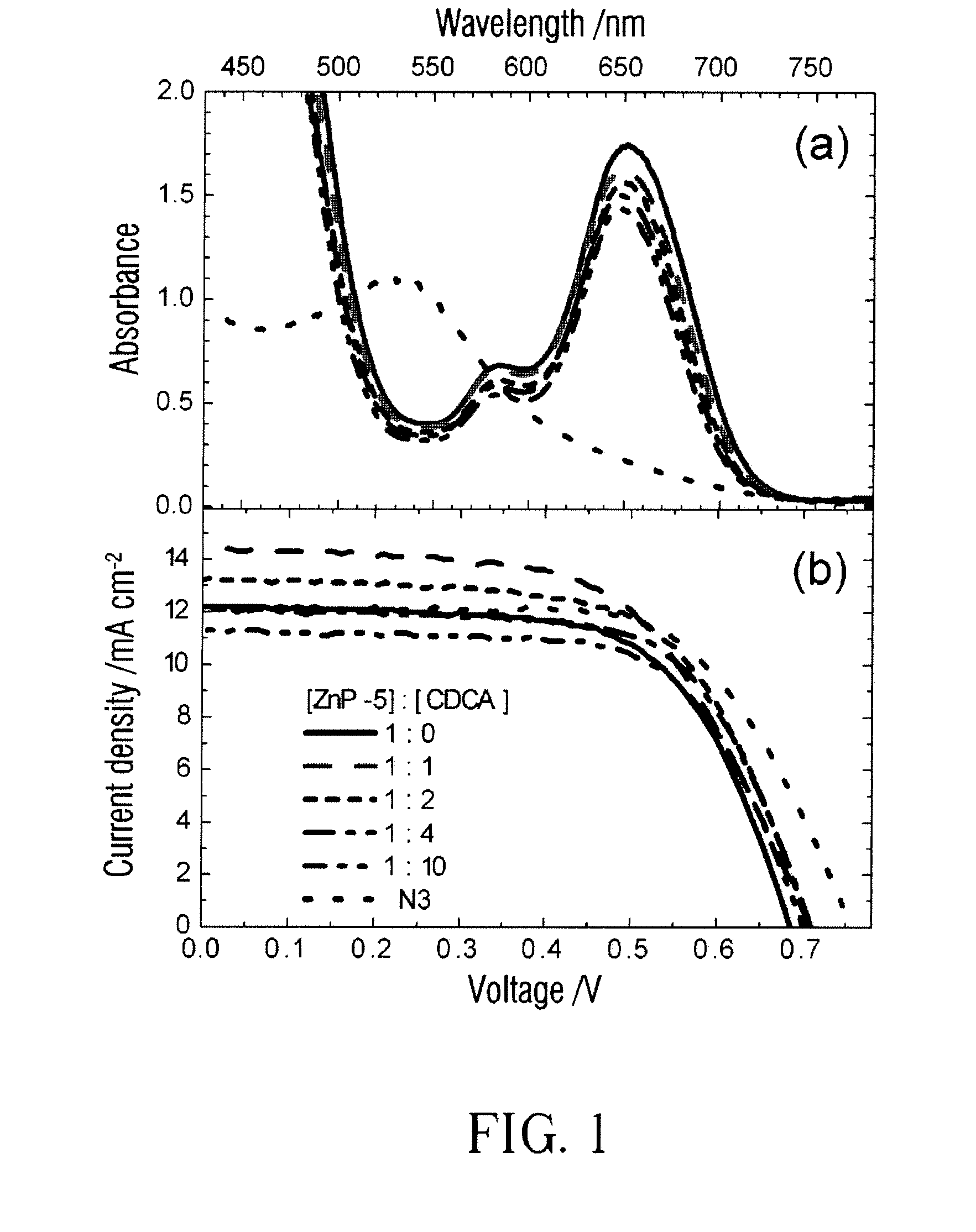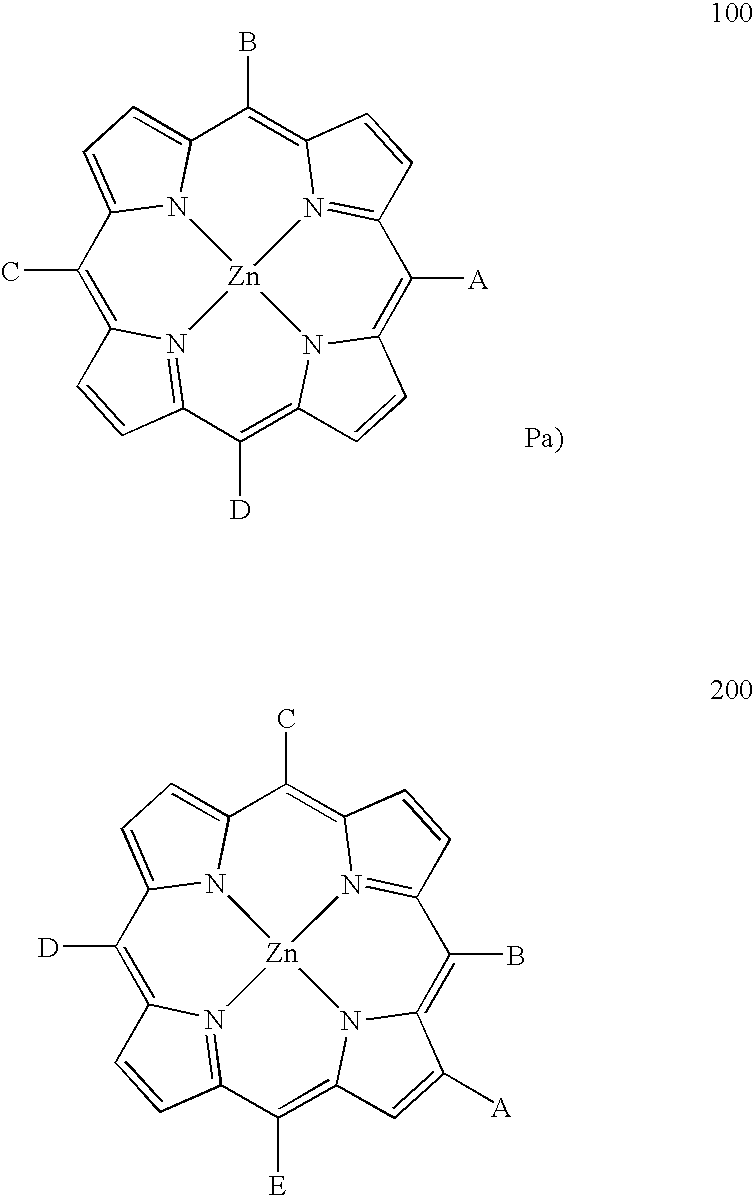Porphyrin-based photosensitizer dyes for dye-sensitized solar cells
a solar cell and photosynthesis technology, applied in the field of solar cell materials, can solve the problems of limited wide application range, large absorption coefficient of poly-pyridyl ru complexes, and limited environmental protection of ru complexes, so as to improve safety, reduce cost, and high absorption coefficient and conversion efficiency
- Summary
- Abstract
- Description
- Claims
- Application Information
AI Technical Summary
Benefits of technology
Problems solved by technology
Method used
Image
Examples
first embodiment
[0015]The Synthesis of Photosensitizer Dye 5
[0016]The chemical reactions listed above are those occur during the synthesis of porphyrin-based photosensitizer dye 5 (referred to as ZnP-5, hereinafter). 373 mg of porphyrin compound 31 (Ka, J. W. et al., Tetrahedron Lett. 2000, 41, 4609; Plater, M. J. et al., Tetrahedron, 2002, 58, 2405; and Susumu, K. et al., J. Am. Chem. Soc. 2002, 124, 8550) was placed in a dry two-necked flask equipped with a stirring bar at the presence of nitrogen gas, followed by adding 80 mL of dry tetrahydrofuran (THF) and 26.8 mL of dry triethylamine (Et3N) thereinto and mix them well. Then the mixture was deoxygenated with nitrogen for 10 minutes. After that, 32.1 mg of bis(triphenylphosphine)palladium(II) chloride (Pd(PPh3)2Cl2, Strem Chemicals, Inc.), 8.7 mg of cuprous iodide (CuI, Strem Chemicals, Inc.), and 0.67 mL of (triisopropylsilyl)acetylene (Acros Organics, Inc.) were added into the flask. The mixture was heated to be refluxed for 2 hours and then ...
second embodiment
[0020]The Synthesis of Photosensitizer Dyes 1 and 2
[0021]Referring to the above chemical equations. A mixture of porphyrinyl iodide 13 (21 mg) and 4-ethynylbenzoic acid (4.4 mg) in dry THF (2 mL) and Et3N (1 mL) was prepared and deoxygenated with nitrogen for 10 minutes, followed by adding palladium(0) tetra(triphenylphosphine) (Pd(PPh3)4, 4.6 mg) and CuI (0.4 mg) thereinto. The mixture was refluxed under nitrogen for 2 hours. The solvent was removed by vacuum, and the residue was purified by column chromatograph (packed with silica gel) using a CH2Cl2 / n-hexane solution (9:1, v / v) as eluent. Recrystallization was then performed using CH2Cl2 / CH3OH, thus resulting in 19.4 mg of photosensitizer dye 1 (ZnP-1) with the yield of 90%.
[0022]Besides, a mixture of porphyrinyl iodide 13 (10 mg) and dimethyl 5-ethynyl-isophthalate 14 (6.5 mg) in dry THF (5 mL) and Et3N (1 mL) was prepared and deoxygenated with nitrogen for 10 minutes, followed by adding Pd2(dba)3 (2.2 mg) and AsPh3 (6 mg) there...
third embodiment
[0024]The Synthesis of Photosensitizer Dyes 3 and 4
[0025]A mixture of N,N-bis(4-methoxyphenyl)-4′-iodophenylamine 19 (10.4 mg), 4-iodobenzoic acid (4 mg), and porphyrin 20 (16 mg) in dry THF (10 mL) and Et3N (2 mL) was prepared and deoxygenated with nitrogen for 10 minutes, followed by adding Pd2(dba)3 (4.4 mg) and AsPh3 (12 mg) thereinto. The mixture was heated and refluxed under nitrogen for 2.5 hours. The solvent was removed by vacuum, and the residue was purified by column chromatograph (packed with silica gel) using a CH2Cl2 / CH3OH solution (9:1, v / v) as eluent. Recrystallization was then performed using CH2Cl2 / CH3OH, leading to 9.8 mg of photosensitizer dye 3 (ZnP-3) with the yield of 40%.
[0026]Similarly, a mixture of 5-iodo-2-methoxy-1,3-di-tert-butylbenzene (8.3 mg), 4-iodobenzoic acid (4 mg), and porphyrin 20 (16 mg) in dry THF (10 mL) and Et3N (2 mL) was prepared and deoxygenated with nitrogen for 10 minutes, followed by adding Pd2(dba)3 (4.4 mg) and AsPh3 (12 mg) thereinto...
PUM
| Property | Measurement | Unit |
|---|---|---|
| diameter | aaaaa | aaaaa |
| thickness | aaaaa | aaaaa |
| wavelength | aaaaa | aaaaa |
Abstract
Description
Claims
Application Information
 Login to View More
Login to View More - R&D
- Intellectual Property
- Life Sciences
- Materials
- Tech Scout
- Unparalleled Data Quality
- Higher Quality Content
- 60% Fewer Hallucinations
Browse by: Latest US Patents, China's latest patents, Technical Efficacy Thesaurus, Application Domain, Technology Topic, Popular Technical Reports.
© 2025 PatSnap. All rights reserved.Legal|Privacy policy|Modern Slavery Act Transparency Statement|Sitemap|About US| Contact US: help@patsnap.com



